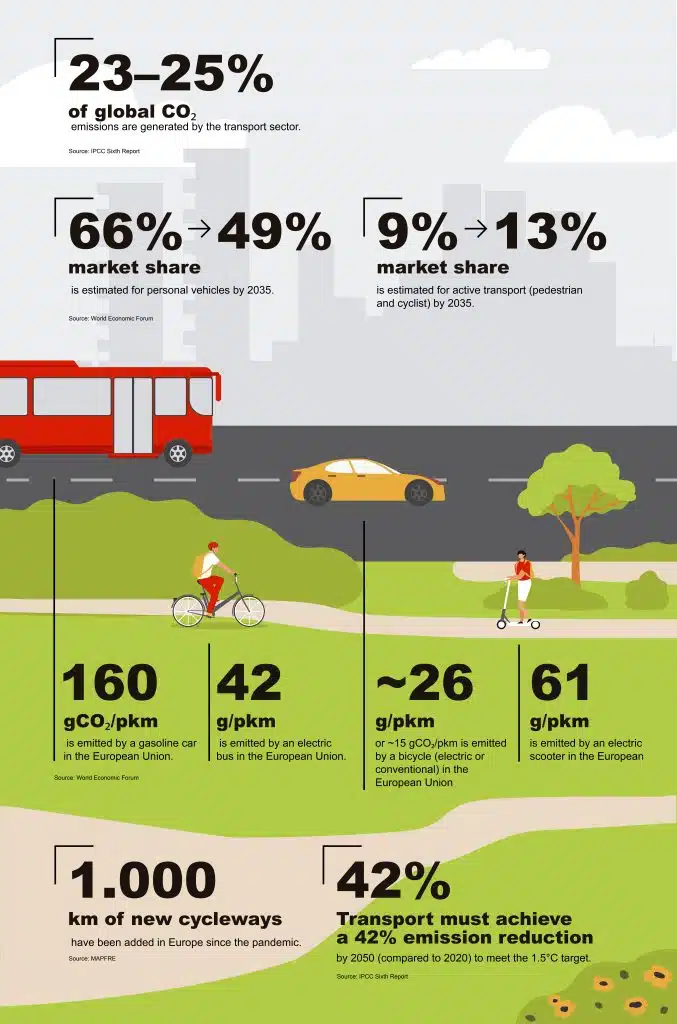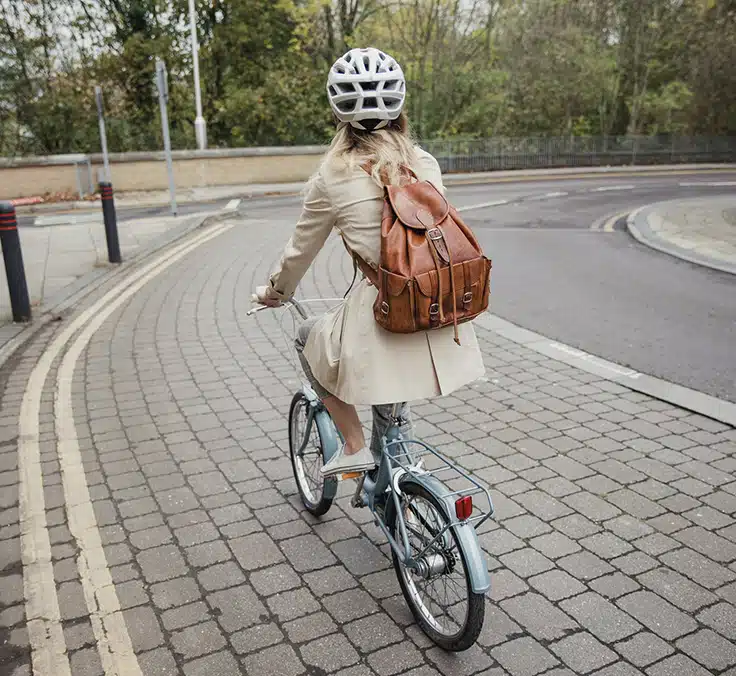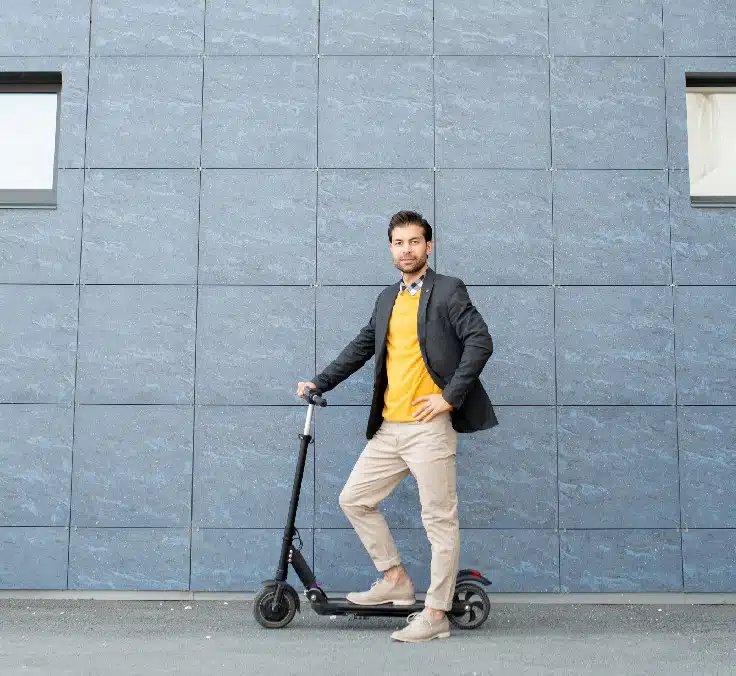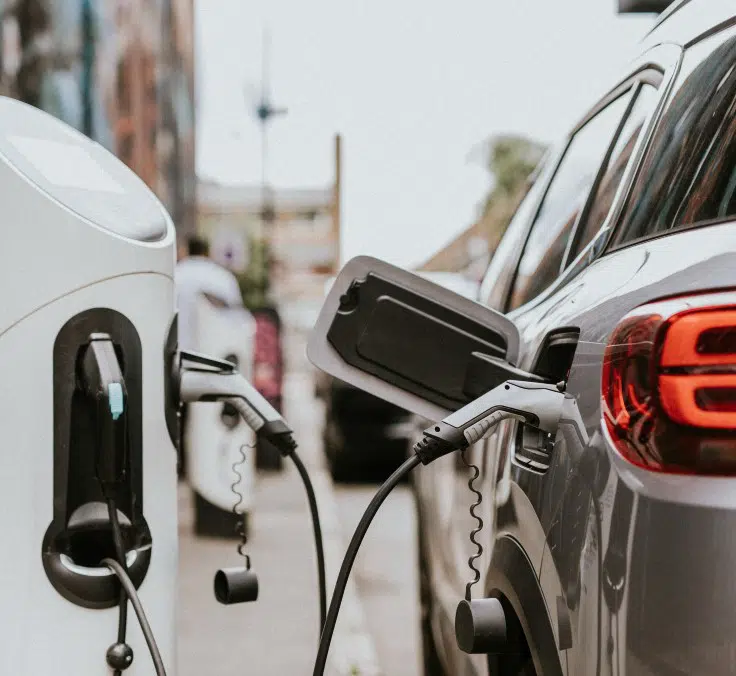SUSTAINABILITY | 07.03.2025
Micromobility, the small (and sustainable) sister in urban transportation
Mobility represents one of the greatest challenges and opportunities in the fight against climate change. Faced with the urgency of reducing emissions, micromobility is emerging as an effective, accessible, and transformative solution. Bicycles, scooters, and other light vehicles are already changing the urban transportation map.
Mobility is a decisive factor in global greenhouse gas emissions. According to thee IPCC, transportation generates approximately 15% of total GHG emissions and about 2% of global energy CO₂. Other sources estimate that transportation activities represent nearly a quarter of global emissions. This makes mobility an inevitable target of climate strategies.
However, the solution is not limited to electrifying conventional vehicles. As Erik Ojantakanen, CEO of Rhyde (a startup that refurbishes scooters and electric bicycles), “electrification is only part of the transition to a sustainable planet.” In his opinion, emissions must be minimized throughout the value chain, and “the best way to do this is to prolong the useful life of each device.” In other words, rather than simply replacing all cars with electric cars, decarbonization also requires changes in transportation demand, the promotion of public transportation, and lighter forms of travel, such as micromobility.
Micromobility to drive the transition
Micromobility promotes the use of light vehicles for short urban journeys, reducing outdoor emissions. It usually refers to small scale individual means of transportation: bicycles (manual or electric), electric scooters, and even light electric motorcycles. The objective is to eliminate emissions from short journeys in urban environments by using light vehicles.
Among its benefits, it first improves public health. By using active modes of transportation (such as cycling or operating light electric vehicles), users incorporate physical exercise into their daily routine.
At the environmental level, the most notable aspect is the zero or very low direct emissions impact. These vehicles do not burn fossil fuels during use, so they do not emit CO₂ or polluting particles at the point of operation. In addition, by occupying significantly less space, they help reduce urban congestion and wear on road infrastructure.
Globally, the trend is clear: cities and governments are increasingly adopting micromobility as a key component of their decarbonization plans. A World Economic Forum report predicts that private vehicle use will fall from 66% to 49% of total mobility demand by 2035, in parallel to increases in active mobility (pedestrian and cyclist, from 9% to 13%) and public transportation. These projections show that more and more short trips will be made on foot, by bicycle, or in shared options.
Some specific examples illustrate this trend. Cities are setting up more and more bicycle lanes and green areas that encourage micromobility as a clean alternative. In Europe, after the pandemic, 1,000 kilometers of bike lanes were added, and the use of cycling increased by 48% in 2020. Countries such as France, Finland, and Italy lead the investment in urban cycling, totaling more than €1,000 million in aid. In Latin America, institutions such as the International Automobile Federation have launched programs to promote micromobility.
Cities and governments are incorporating micromobility as a key part of their decarbonization plans
In the business sector, major micromobility platforms are beginning to establish themselves in the market, backed by data. Lime, operator of e-scooters and shared bicycles, points out that its users have taken 450 million trips, replacing around 100 million automobile trips and avoiding more than 40,000 tons of CO₂. It is just an example of how light and shared solutions can complement the decarbonization of transport. In New York alone, its pilot scooter program in the Bronx recorded over 1.2 million trips since its launch, preventing 100 tons of emissions and 275,000 car trips.

There are also notable advances in Spain. Alongside specific business initiatives, public strategies are also beginning to gain momentum. For example, Spain’s Safe, Sustainable, and Connected Mobility Strategy 2030 aims to promote micromobility through expanded urban infrastructure and adapted regulations. Programs such as that of Madrid (BiciMAD) or the bike lanes in cities like Valencia and Barcelona serve as key points of reference. All of this points to a growing global framework for action: international organizations, governments, and companies are demonstrating their commitment to policies that include micromobility as an ally in the ecological transition.
Road safety, a key element in the transition
For this transformation to be sustainable, it must also be safe. Road safety is a fundamental, often underestimated aspect that must go hand in hand with the rollout of light vehicles. Encouraging helmet use, securing appropriate liability insurance, and avoiding riding on sidewalks are key measures to protect both users and pedestrians.
Regulations must evolve to support this shift, but public education is equally important: promoting respect for traffic rules, the use of lights and reflectors at night, and better coexistence between different modes of transportation is essential to ensure that the growth of micromobility does not lead to an increase in urban accidents.
At MAPFRE, we work every day for more sustainable mobility, both inside and outside the organization. Through projects developed by CESVIMAP or the innovation teams, we are committed to innovation and green entrepreneurship, supporting startups that promote circular and responsible models. A good example of this is our collaboration with the aforementioned startup Rhyde
In this spirit, we have decided to participate in the United Nations Climate Change Conference (COP30) to demonstrate our commitment to the fight against climate change and to engage in discussions about the risks and solutions the sector can offer for the ecological transition.
We are certain that the transition to more sustainable mobility depends not only on new technologies, but also on a profound change in the way we travel. It also involves a cultural and mindset transformation: rethinking our daily habits, prioritizing cleaner alternatives, and committing to mobility that is both sustainable and safe.
RELATED ARTICLES:




